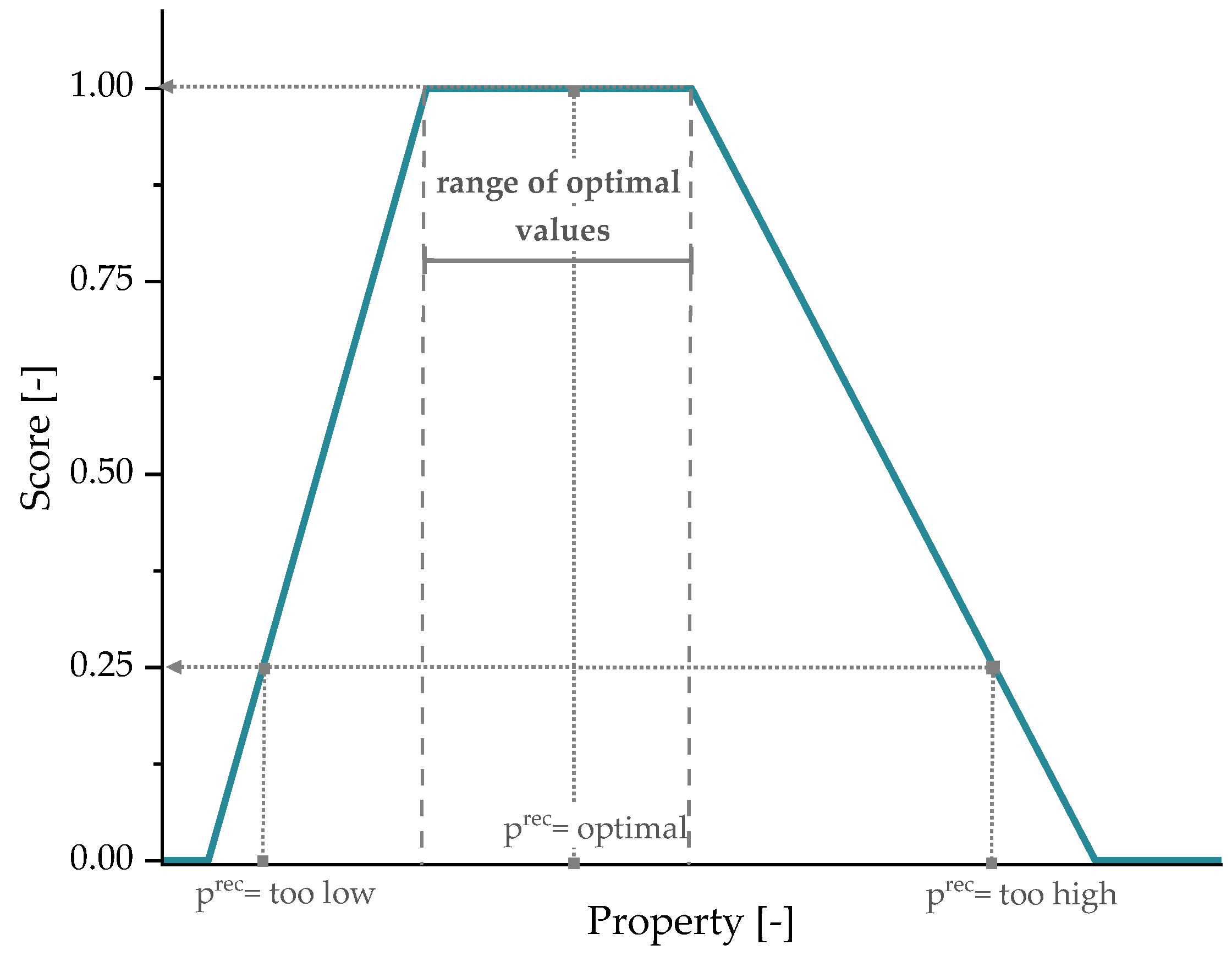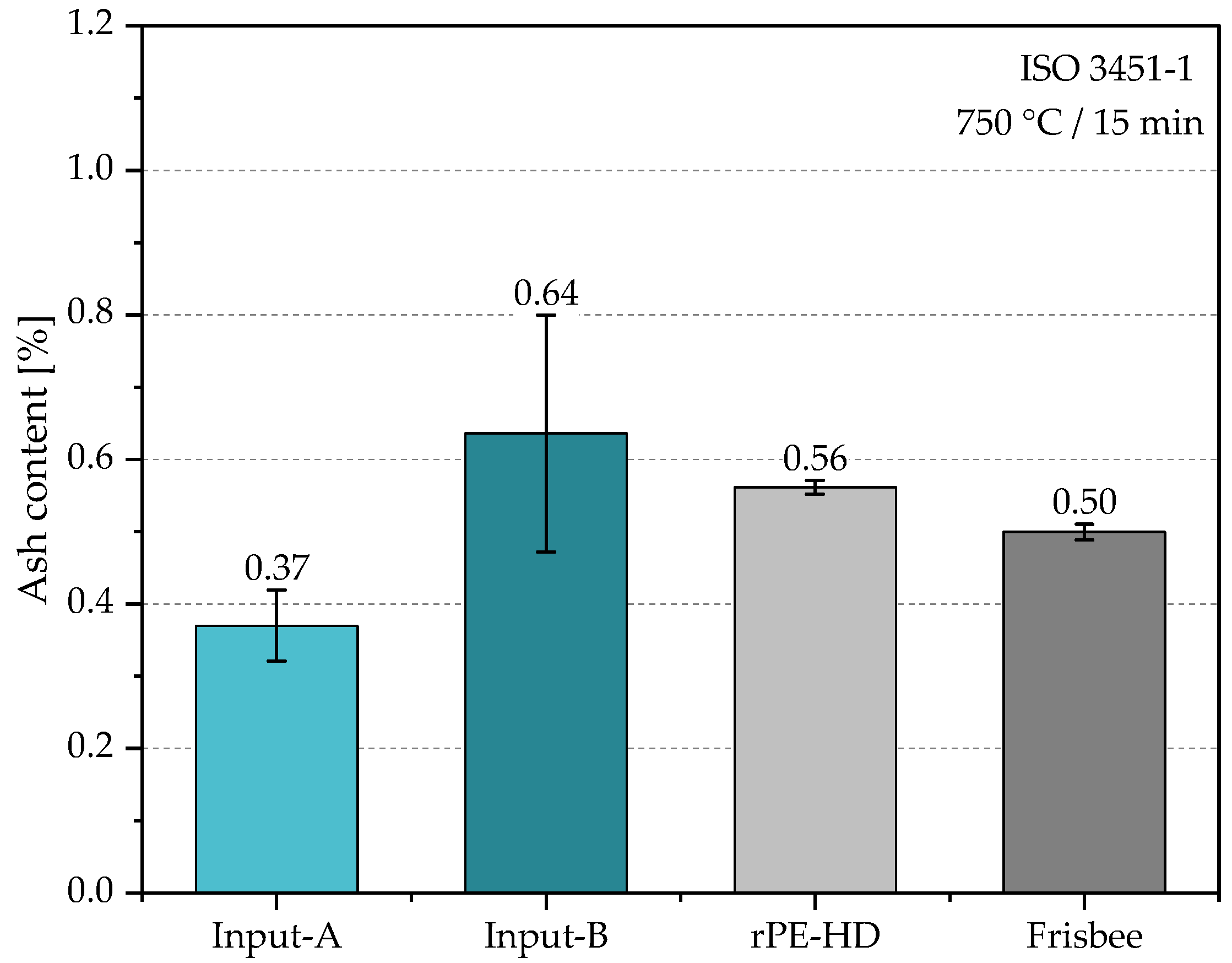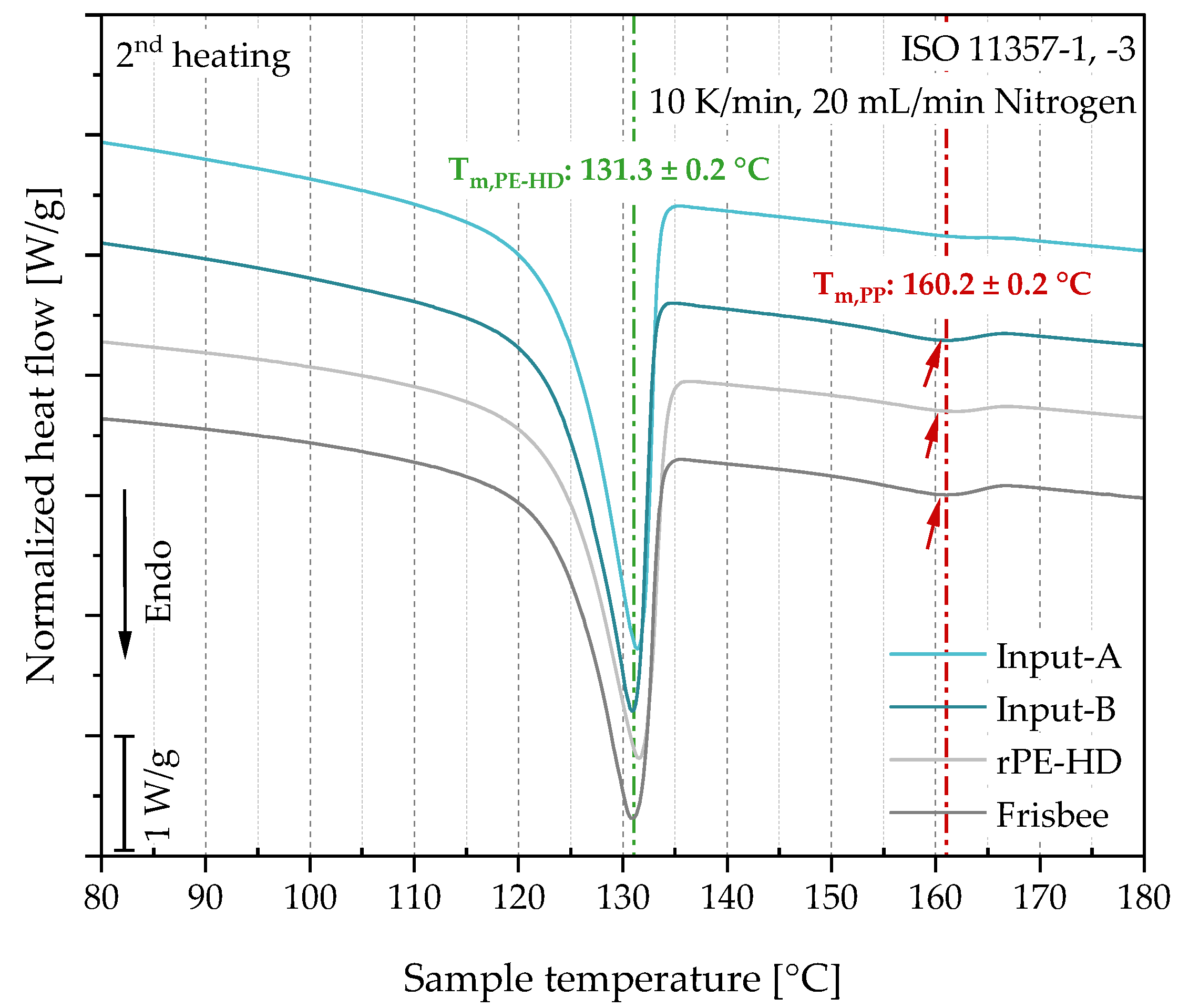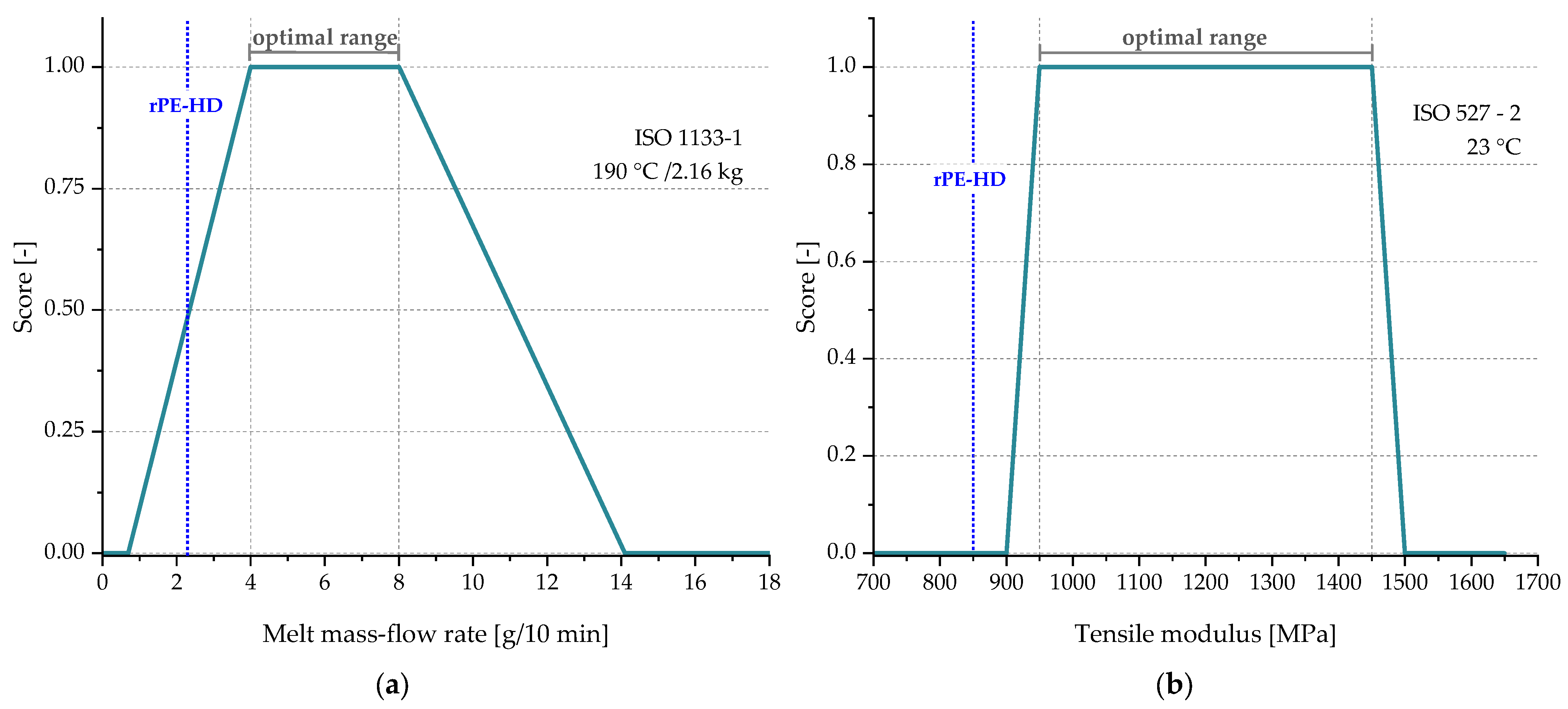From Bottle Caps to Frisbee—A Case Study on Mechanical Recycling of Plastic Waste towards a Circular Economy
Abstract
:1. Introduction
2. Materials and Methodology
2.1. Scope of the Case Study “From Bottle Cap to Frisbee”
2.2. Material Processing
2.3. Material Characterization Methods
2.3.1. Sample Preparation
2.3.2. Material Processability
2.3.3. Thermal Analysis
2.3.4. Mechanical Testing
2.4. Review of Selected Commercial Packaging Grades
2.5. Material Assessment Using the Substitution Potential Concept
3. Results
3.1. Material Evaluation
3.1.1. Material Processability
3.1.2. Thermal Properties and Stability
3.1.3. Mechanical Performance
3.2. Technical Performace of the Recyclate based on Market Information
4. Discussion
5. Conclusions
Author Contributions
Funding
Data Availability Statement
Acknowledgments
Conflicts of Interest
Correction Statement
References
- European Commission. A new Circular Economy Action Plan For a Cleaner and More Competitive Europe. 2020. Available online: https://eur-lex.europa.eu/legal-content/EN/TXT/?uri=COM%3A2020%3A98%3AFIN (accessed on 13 January 2022).
- Geyer, R.; Jambeck, J.R.; Law, K.L. Production, use, and fate of all plastics ever made. Sci. Adv. 2017, 3, e1700782. [Google Scholar] [CrossRef]
- Gall, M.; Wiener, M.; de Oliveira, C.C.; Lang, R.W.; Hansen, E.G. Building a circular plastics economy with informal waste pickers: Recyclate quality, business model, and societal impacts. Resour. Conserv. Recycl. 2020, 156, 104685. [Google Scholar] [CrossRef]
- Thompson, R.C.; Swan, S.H.; Moore, C.J.; vom Saal, F.S. Our plastic age. Philos. Trans. R. Soc. Lond. B Biol. Sci. 2009, 364, 1973–1976. [Google Scholar] [CrossRef] [PubMed]
- Plastics Europe. Plastics–The Facts. Available online: https://plasticseurope.org/knowledge-hub/plastics-the-facts-2022/ (accessed on 20 January 2023).
- Hundertmark, T.; Mayer, M.; McNally, C.; Simons, T.J.; Witte, C. How Plastics Waste Recycling Could Transform the Chemical Industry. Available online: https://www.mckinsey.com/industries/chemicals/our-insights/how-plastics-waste-recycling-could-transform-the-chemical-industry (accessed on 17 August 2022).
- European Commission. A European Strategy for Plastics in a Circular Economy. Available online: https://eur-lex.europa.eu/legal-content/EN/TXT/?qid=1516265440535&uri=COM:2018:28:FIN (accessed on 17 August 2022).
- R-Cycle. The Digital Product Passport. Available online: https://www.r-cycle.org/en/digital-product-passport.html (accessed on 17 March 2023).
- Chris Stretton. Digital Product Passports (DPP): What, How, and Why? Available online: https://www.circularise.com/blogs/digital-product-passports-dpp-what-how-and-why (accessed on 17 March 2023).
- Eriksen, M.K.; Damgaard, A.; Boldrin, A.; Astrup, T.F. Quality Assessment and Circularity Potential of Recovery Systems for Household Plastic Waste. J. Ind. Ecol. 2019, 23, 156–168. [Google Scholar] [CrossRef]
- van Eygen, E.; Laner, D.; Fellner, J. Circular economy of plastic packaging: Current practice and perspectives in Austria. Waste Manag. 2018, 72, 55–64. [Google Scholar] [CrossRef] [PubMed]
- Hahladakis, J.N.; Iacovidou, E. Closing the loop on plastic packaging materials: What is quality and how does it affect their circularity? Sci. Total Environ. 2018, 630, 1394–1400. [Google Scholar] [CrossRef] [PubMed]
- Hahladakis, J.N.; Iacovidou, E. An overview of the challenges and trade-offs in closing the loop of post-consumer plastic waste (PCPW): Focus on recycling. J. Hazard. Mater. 2019, 380, 120887. [Google Scholar] [CrossRef] [PubMed]
- Ellen Macarthur Foundation. The New Plastics Economy: Catalysing Action. Available online: https://emf.thirdlight.com/link/u3k3oq221d37-h2ohow/@/preview/1?o (accessed on 8 September 2021).
- Gall, M.; Schweighuber, A.; Buchberger, W.; Lang, R. Plastic Bottle Cap Recycling—Characterization of Recyclate Composition and Opportunities for Design for Circularity. Sustainability 2020, 12, 10378. [Google Scholar] [CrossRef]
- Welle, F. Twenty years of PET bottle to bottle recycling—An overview. Resour. Conserv. Recycl. 2011, 55, 865–875. [Google Scholar] [CrossRef]
- Kang, D.H.; Auras, R.; Vorst, K.; Singh, J. An exploratory model for predicting post-consumer recycled PET content in PET sheets. Polym. Test. 2011, 30, 60–68. [Google Scholar] [CrossRef]
- Shen, L.; Worrell, E.; Patel, M.K. Open-loop recycling: A LCA case study of PET bottle-to-fibre recycling. Resour. Conserv. Recycl. 2010, 55, 34–52. [Google Scholar] [CrossRef]
- Oliveira, P.R.; Panzera, T.H.; Freire, R.T.; Scarpa, F. Sustainable sandwich structures made from bottle caps core and aluminium skins: A statistical approach. Thin-Walled Struct. 2018, 130, 362–371. [Google Scholar] [CrossRef]
- Unal, N.I.; Mertdinc, S.; Haykiri-Acma, H.; Yaman, S. Comparison of the fuel properties and the combustion behavior of PET bottle caps with lignite. Energy Procedia 2017, 136, 22–26. [Google Scholar] [CrossRef]
- Boonstra, M.; van Hest, F. The Plastic Bottle Cap Report: Findings of the First Survey into Plastic Bottle Cap Pollution on Beaches in the Netherlands. 2017. Available online: https://www.diveagainstdebris.org/news/ugly-journey-plastic-bottle-cap (accessed on 14 November 2022).
- Nikolaev, A.A. The Physical Characterization and Terminal Velocities of Aluminium, Iron and Plastic Bottle Caps in a Water Environment. Recycling 2022, 7, 28. [Google Scholar] [CrossRef]
- Directive (EU) 2019/904 of the European Parliament and of the Council. On the Reduction of the Impact of Certain Plastic Products on the Environment. Available online: https://eur-lex.europa.eu/EN/legal-content/summary/single-use-plastics-fighting-the-impact-on-the-environment.html (accessed on 9 June 2023).
- LIT Factory. Bottle Empty, Frisbee Here-Our Action for Better Recycling Becomes Digital. 2022. Available online: https://www.jku.at/en/lit-factory/research/use-cases/r-cyclejku/ (accessed on 7 November 2022).
- Otles, S.; Ozyurt, V.H. Sampling and Sample Preparation. In Handbook of Food Chemistry; Cheung, P.C.K., Mehta, B.M., Eds.; Springer: Berlin/Heidelberg, Germany, 2015; pp. 151–164. ISBN 978-3-642-36604-8. [Google Scholar]
- Dulski, T.R. Sample Preparation, Encyclopedia Britannica. 2016. Available online: https://www.britannica.com/science/sample-preparation (accessed on 1 April 2023).
- Akhras, M.H.; Fischer, J. Sampling Scheme Conception for Pretreated Polyolefin Waste Based on a Review of the Available Standard Procedures. Polymers 2022, 14, 3450. [Google Scholar] [CrossRef] [PubMed]
- Bicking, C.A. ASTM E105-58 and ASTM E300-69, Standards for the Sampling of Bulk Materials. J. Qual. Technol. 1970, 2, 165–173. [Google Scholar] [CrossRef]
- International Standardization Organization. Plastics–Polyethylene (PE) Moulding and Extrusion Materials–Part 2: Preparation of Test Specimens and Determination of Properties, 2016 (ISO 17855-1). Available online: https://www.iso.org/standard/66827.html (accessed on 7 January 2023).
- International Standardization Organization. Plastics–Multipurpose Test Specimens, 2014 (ISO 3167). Available online: https://www.iso.org/standard/65105.html (accessed on 10 January 2023).
- International Standardization Organization. Plastics–Injection Moulding of Test Specimens of Thermoplastic Materials–Part 2: Small Tensile Bars, 2018 (ISO 294-2). Available online: https://www.iso.org/standard/70412.html (accessed on 10 January 2023).
- International Standardization Organization. Plastics–Determination of Charpy Impact Properties–Part 1: Non-Instrumented Impact Test, 2010 (ISO 179-1). Available online: https://www.iso.org/standard/44852.html (accessed on 2 November 2022).
- International Standardization Organization. Plastics–Standard Atmospheres for Conditioning and Testing, 2008 (ISO 291). Available online: https://www.iso.org/standard/50572.html (accessed on 2 November 2022).
- ASTM International. Test Methods for Particle Size (Sieve Analysis) of Plastic Materials, 2018 (ASTM D1921). Available online: https://www.astm.org/d1921-18.html (accessed on 1 November 2021).
- Mills, D. Pneumatic Conveying Design Guide, 3rd ed.; Butterworth-Heinemann: Oxford, UK, 2016; ISBN 9780081006498. [Google Scholar]
- ASTM International. Test Methods for Apparent Density, Bulk Factor, and Pourability of Plastic Materials, 2017 (ASTM D1895). Available online: https://www.astm.org/d1895-17.html (accessed on 1 August 2021).
- International Standardization Organization. Plastics–Determination of the Melt Mass-Flow Rate (MFR) and Melt Volume-Flow Rate (MVR) of Thermoplastics–Part 1: Standard Method, 2022 (ISO 1133-1). Available online: https://www.iso.org/standard/83905.html (accessed on 18 October 2022).
- Möllnitz, S.; Feuchter, M.; Duretek, I.; Schmidt, G.; Pomberger, R.; Sarc, R. Processability of Different Polymer Fractions Recovered from Mixed Wastes and Determination of Material Properties for Recycling. Polymers 2021, 13, 457. [Google Scholar] [CrossRef] [PubMed]
- International Standardization Organization. Plastics–Determination of Ash–Part 1: General Methods, 2019 (ISO 3451-1). Available online: https://www.iso.org/standard/71205.html (accessed on 4 November 2022).
- International Standardization Organization. Plastics–Differential Scanning Calorimetry (DSC)–Part 1: General Principles, 2016 (ISO 11357–1). Available online: https://www.iso.org/standard/70024.html (accessed on 4 November 2022).
- International Standardization Organization. Plastics–Differential Scanning Calorimetry (DSC)–Part 3: Determination of Temperature and Enthalpy of Melting and Crystallization, 2018 (ISO 11357-3). Available online: https://www.iso.org/standard/72460.html (accessed on 4 November 2022).
- International Standardization Organization. Plastics–Differential Scanning Calorimetry (DSC)–Part 6: Determination of Oxidation Induction Time (Isothermal OIT) and Oxidation Induction Temperature (Dynamic OIT), 2018 (ISO 11357-6). Available online: https://www.iso.org/standard/72461.html (accessed on 4 November 2022).
- International Standardization Organization. Plastics–Determination of Tensile Properties–Part 3: Test Conditions for Films and Sheets, 2018 (ISO 527-3). Available online: https://www.iso.org/standard/70307.html (accessed on 20 October 2022).
- International Standardization Organization. Plastics–Determination of Tensile Properties–Part 1: General Principles, 2019 (ISO 527-1). Available online: https://www.iso.org/standard/75824.html (accessed on 20 October 2022).
- International Standardization Organization. Plastics–Determination of Tensile Properties–Part 2: Test Conditions for Moulding and Extrusion Plastics, 2012 (ISO 527-2). Available online: https://www.iso.org/standard/56046.html (accessed on 20 October 2022).
- Chatterjee, A.M. Handbook of Industrial Polyethylene Technology: Definitive Guide to Manufacturing, Properties, Processing, Applications and Markets; John Wiley & Sons, Inc.: Beverly, MA, USA, 2018; ISBN 9781119159766. [Google Scholar]
- Demets, R.; van Kets, K.; Huysveld, S.; Dewulf, J.; de Meester, S.; Ragaert, K. Addressing the complex challenge of understanding and quantifying substitutability for recycled plastics. Resour. Conserv. Recycl. 2021, 174, 105826. [Google Scholar] [CrossRef]
- Reusable Packaging Association. Plastic Boxes and Containers: Material and Design Considerations. Available online: https://reusables.org/wp-content/uploads/2014/05/Plastic-Boxes-and-Containers-Material-and-Design-Considerations.pdf (accessed on 11 October 2022).
- Borealis, A.G. Transport Packaging. Available online: https://www.borealisgroup.com/polyolefins/consumer-products/rigid-packaging/transport-packaging (accessed on 14 February 2023).
- Borealis, A.G. Solutions for Moulding Applications: Summary data sheet. Available online: https://www.borealisgroup.com/storage/Polyolefins/Consumer-Products/solutions-for-moulding-applications.pdf (accessed on 10 February 2023).
- SABIC. SABIC® HDPE: Caps and Closures. 2022. Available online: https://www.sabic.com/en/products/polymers/polyethylene-pe/sabic-hdpe (accessed on 26 January 2023).
- Lyondellbasell. Product Selection Guide-Grades Used in Injection Molding Applications. Available online: https://www.lyondellbasell.com/en/products-technology/polymers/application/crates/ (accessed on 13 February 2023).
- Lyondellbasell. Product Selection Guid-Caps, Closures, and Tubes. Available online: https://www.lyondellbasell.com/en/products-technology/polymers/application/caps--closures/ (accessed on 26 January 2023).
- Viau, S.; Majeau-Bettez, G.; Spreutels, L.; Legros, R.; Margni, M.; Samson, R. Substitution modelling in life cycle assessment of municipal solid waste management. Waste Manag. 2020, 102, 795–803. [Google Scholar] [CrossRef] [PubMed]
- Vadenbo, C.; Hellweg, S.; Astrup, T.F. Let’s Be Clear(er) about Substitution: A Reporting Framework to Account for Product Displacement in Life Cycle Assessment. J. Ind. Ecol. 2017, 21, 1078–1089. [Google Scholar] [CrossRef]
- Zink, T.; Geyer, R.; Startz, R. A Market-Based Framework for Quantifying Displaced Production from Recycling or Reuse. J. Ind. Ecol. 2016, 20, 719–729. [Google Scholar] [CrossRef]
- Rigamonti, L.; Taelman, S.E.; Huysveld, S.; Sfez, S.; Ragaert, K.; Dewulf, J. A step forward in quantifying the substitutability of secondary materials in waste management life cycle assessment studies. Waste Manag. 2020, 114, 331–340. [Google Scholar] [CrossRef]
- Roithner, C.; Rechberger, H. Implementing the dimension of quality into the conventional quantitative definition of recycling rates. Waste Manag. 2020, 105, 586–593. [Google Scholar] [CrossRef]
- Eriksen, M.K.; Astrup, T.F. Characterisation of source-separated, rigid plastic waste and evaluation of recycling initiatives: Effects of product design and source-separation system. Waste Manag. 2019, 87, 161–172. [Google Scholar] [CrossRef]
- Huysveld, S.; Ragaert, K.; Demets, R.; Nhu, T.T.; Civancik-Uslu, D.; Kusenberg, M.; van Geem, K.M.; de Meester, S.; Dewulf, J. Technical and market substitutability of recycled materials: Calculating the environmental benefits of mechanical and chemical recycling of plastic packaging waste. Waste Manag. 2022, 152, 69–79. [Google Scholar] [CrossRef]
- Petersen, L.; Minkkinen, P.; Esbensen, K.H. Representative sampling for reliable data analysis: Theory of Sampling. Chemom. Intell. Lab. Syst. 2005, 77, 261–277. [Google Scholar] [CrossRef]
- Best Process Solutions, Inc. Bulk Material Density Guide. Available online: https://www.bpsvibes.com/bulk-material-density-guide/ (accessed on 1 August 2022).
- Yin, S.; Tuladhar, R.; Shi, F.; Shanks, R.A.; Combe, M.; Collister, T. Mechanical reprocessing of polyolefin waste: A review. Polym. Eng. Sci. 2015, 55, 2899–2909. [Google Scholar] [CrossRef]
- Wunderlich, B.K. Thermal Analysis of Polymeric Materials; Springer: Berlin/Heidelberg, Germany, 2005; ISBN 3-540-23629-5. [Google Scholar]
- Awad, A.H.; Aly Abd El-Wahab, A.; El-Gamsy, R.; Abdel-latif, M.H. A study of some thermal and mechanical properties of HDPE blend with marble and granite dust. Ain Shams Eng. J. 2019, 10, 353–358. [Google Scholar] [CrossRef]
- Freudenthaler, P.J.; Fischer, J.; Lang, R.W. Assessment of Commercially Available Polyethylene Recyclates for Blow Molding Applications by a Novel Environmental Stress Cracking Method. Polymers 2022, 15, 46. [Google Scholar] [CrossRef] [PubMed]
- Ren, Y.; Sun, X.; Chen, L.; Li, Y.; Sun, M.; Duan, X.; Liang, W. Structures and impact strength variation of chemically crosslinked high-density polyethylene: Effect of crosslinking density. RSC Adv. 2021, 11, 6791–6797. [Google Scholar] [CrossRef]
- Pinheiro, L.A.; Chinelatto, M.A.; Canevarolo, S.V. The role of chain scission and chain branching in high density polyethylene during thermo-mechanical degradation. Polym. Degrad. Stab. 2004, 86, 445–453. [Google Scholar] [CrossRef]
- Canevarolo, S.V. Chain scission distribution function for polypropylene degradation during multiple extrusions. Polym. Degrad. Stab. 2000, 70, 71–76. [Google Scholar] [CrossRef]
- Aurrekoetxea, J.; Sarrionandia, M.A.; Urrutibeascoa, I.; Maspoch, M.L. Effects of recycling on the microstructure and the mechanical properties of isotactic polypropylene. J. Mater. Sci. 2001, 36, 2607–2613. [Google Scholar] [CrossRef]
- Shafigullin, L.N.; Romanova, N.V.; Gumerov, I.F.; Gabrakhmanov, A.T.; Sarimov, D.R. Thermal properties of polypropylene and polyethylene blends (PP/LDPE). IOP Conf. Ser. Mater. Sci. Eng. 2018, 412, 12070. [Google Scholar] [CrossRef]
- van Belle, A.; Demets, R.; Mys, N.; van Kets, K.; Dewulf, J.; van Geem, K.; de Meester, S.; Ragaert, K. Microstructural Contributions of Different Polyolefins to the Deformation Mechanisms of Their Binary Blends. Polymers 2020, 12, 1171. [Google Scholar] [CrossRef]
- Gall, M.; Freudenthaler, P.J.; Fischer, J.; Lang, R.W. Characterization of Composition and Structure-Property Relationships of Commercial Post-Consumer Polyethylene and Polypropylene Recyclates. Polymers 2021, 13, 1574. [Google Scholar] [CrossRef]
- Mendes, A.A.; Cunha, A.M.; Bernardo, C.A. Study of the degradation mechanisms of polyethylene during reprocessing. Polym. Degrad. Stab. 2011, 96, 1125–1133. [Google Scholar] [CrossRef]
- Tai, C.; Li, R.K.; Ng, C. Impact behaviour of polypropylene/polyethylene blends. Polym. Test. 2000, 19, 143–154. [Google Scholar] [CrossRef]
- Mellott, S.R. Tensile, Creep, and Fatigue Behaviors of Thermoplastics Including Thickness, Mold Flow Direction, Mean Stress, Temperature, and Loading Rate Effects. Master’s Thesis, Master of Science in Mechanical Engineering, University of Toledo, College of Engineering, Toledo, OH, USA, 2012. Available online: http://rave.ohiolink.edu/etdc/view?acc_num=toledo1344541288 (accessed on 8 March 2023).
- Amjadi, M.; Fatemi, A. Tensile Behavior of High-Density Polyethylene Including the Effects of Processing Technique, Thickness, Temperature, and Strain Rate. Polymers 2020, 12, 1857. [Google Scholar] [CrossRef] [PubMed]
- van Thoden Velzen, E.U.; Chu, S.; Alvarado Chacon, F.; Brouwer, M.T.; Molenveld, K. The impact of impurities on the mechanical properties of recycled polyethylene. Packag. Technol. Sci. 2021, 34, 219–228. [Google Scholar] [CrossRef]
- Oyinlola, M.; Whitehead, T.; Abuzeinab, A.; Adefila, A.; Akinola, Y.; Anafi, F.; Farukh, F.; Jegede, O.; Kandan, K.; Kim, B.; et al. Bottle house: A case study of transdisciplinary research for tackling global challenges. Habitat Int. 2018, 79, 18–29. [Google Scholar] [CrossRef]
- Haque, M.S. Sustainable use of plastic brick from waste PET plastic bottle as building block in Rohingya refugee camp: A review. Environ. Sci. Pollut. Res. Int. 2019, 26, 36163–36183. [Google Scholar] [CrossRef]
- Taaffe, J.; O’Sullivan, S.; Rahman, M.E.; Pakrashi, V. Experimental characterisation of Polyethylene Terephthalate (PET) bottle Eco-bricks. Mater. Des. 2014, 60, 50–56. [Google Scholar] [CrossRef]
- Juan, R.; Paredes, B.; García-Muñoz, R.A.; Domínguez, C. Quantification of PP contamination in recycled PE by TREF analysis for improved the quality and circularity of plastics. Polym. Test. 2021, 100, 107273. [Google Scholar] [CrossRef]
- Dahlbo, H.; Poliakova, V.; Mylläri, V.; Sahimaa, O.; Anderson, R. Recycling potential of post-consumer plastic packaging waste in Finland. Waste Manag. 2018, 71, 52–61. [Google Scholar] [CrossRef]
- Dahlén, L.; Berg, H.; Lagerkvist, A.; Berg, P.E.O. Inconsistent pathways of household waste. Waste Manag. 2009, 29, 1798–1806. [Google Scholar] [CrossRef] [PubMed]
- Dahlén, L.; Vukicevic, S.; Meijer, J.-E.; Lagerkvist, A. Comparison of different collection systems for sorted household waste in Sweden. Waste Manag. 2007, 27, 1298–1305. [Google Scholar] [CrossRef]
- Kamleitner, F.; Duscher, B.; Koch, T.; Knaus, S.; Archodoulaki, V.M. Upcycling of polypropylene-the influence of polyethylene impurities. Polym. Eng. Sci. 2017, 57, 1374–1381. [Google Scholar] [CrossRef]
- Teh, J.W.; Rudin, A.; Keung, J.C. A review of polyethylene–polypropylene blends and their compatibilization. Adv. Polym. Technol. 1994, 13, 1–23. [Google Scholar] [CrossRef]
- Jose, S.; Aprem, A.; Francis, B.; Chandy, M.; Werner, P.; Alstaedt, V.; Thomas, S. Phase morphology, crystallisation behaviour and mechanical properties of isotactic polypropylene/high density polyethylene blends. Eur. Polym. J. 2004, 40, 2105–2115. [Google Scholar] [CrossRef]
- Messiha, M.; Frank, A.; Koch, T.; Arbeiter, F.; Pinter, G. Effect of polyethylene and polypropylene cross-contamination on slow crack growth resistance. Int. J. Polym. Anal. Charact. 2020, 25, 649–666. [Google Scholar] [CrossRef]
- Balani, K. Biosurfaces: A Materials Science and Engineering Perspective, 1st ed.; Wiley: Hoboken, NJ, USA, 2015; ISBN 9781118950630. [Google Scholar]
- Freudenthaler, P.J.; Fischer, J.; Liu, Y.; Lang, R.W. Short- and Long-Term Performance of Pipe Compounds Containing Polyethylene Post-Consumer Recyclates from Packaging Waste. Polymers 2022, 14, 1581. [Google Scholar] [CrossRef] [PubMed]
- Zhang, J.; Hirschberg, V.; Rodrigue, D. Blending Recycled High-Density Polyethylene HDPE (rHDPE) with Virgin (vHDPE) as an Effective Approach to Improve the Mechanical Properties. Recycling 2023, 8, 2. [Google Scholar] [CrossRef]
- Jasso-Gastinel, C.F.; Soltero-Martínez, J.; Mendizábal, E. Introduction: Modifiable Characteristics and Applications. In Modification of Polymer Properties; Jasso-Gastinel, C.F., Kenny, J.M., Eds.; Elsevier: Boston, MA, USA, 2017; pp. 1–21. ISBN 9780323443531. [Google Scholar]
- Ambrogi, V.; Carfagna, C.; Cerruti, P.; Marturano, V. Additives in Polymers. In Modification of Polymer Properties; Jasso-Gastinel, C.F., Kenny, J.M., Eds.; Elsevier: Boston, MA, USA, 2017; pp. 87–108. ISBN 9780323443531. [Google Scholar]












| Designation | Source | Processing Technology | Form |
|---|---|---|---|
| Input-A | Schools (informal) | Shredding | Flakes |
| Input-B | Collection centers (formal) | Shredding | Flakes |
| rPE-HD | - | Regranulation | Pellets |
| Frisbee | - | Injection molding | Product |
| Test Conditions | Input | Output1 | Output2 | ||||
|---|---|---|---|---|---|---|---|
| Test Method\Material | Standard Method | No. of Measurements | Informal (A) | Formal (B) | Recyclate (rPE-HD) | Product (Frisbee) | |
| Material Processability | |||||||
| Flake size distribution (FSD) | ASTM D1921 | 1, ca. 1 kg | X | X | |||
| Apparent density (AD) | ASTM D1895, method C | 3, 60.0 ± 0.2 g | X | X | X | ||
| Melt flow rate (MFR) | ISO 01133-1, method B | 3, ca. 4 g | X | X | X | X | |
| Thermal Analysis | |||||||
| Ash content (AC) | ISO 3451-1, method A | 3, ca. 4 g | X | X | X | X | |
| Differential scanning calorimetry (DSC) | ISO 11357-1 and -3 | 3, 8 ± 1 mg | X | X | X | X | |
| Oxidation induction temperature (OIT) | ISO 11357-1 and -6 | 3, 8 ± 1 mg | X | X | X | X | |
| Mechanical Tests | |||||||
| Tensile tests | ISO 527-1 and -3 | 10 specimens, MPS and type 5 | X | X | X | X | |
| Charpy notched impact tests | ISO 179-1 | −20 °C | 10 specimens, type 1 | X | X | X | |
| 23 °C | |||||||
| Material | Melting Temperature, Tm [°C] | Melting Enthalpy, ∆H [J/g] | ||||||
|---|---|---|---|---|---|---|---|---|
| PE-HD | PP | PE-HD | PP | |||||
| Input-A | 131.4 | ±0.0 | 160.4 | ±0.4 | 190.3 | ±5.8 | 2.1 | ±0.4 |
| Input-B | 131.0 | ±0.1 | 159.9 | ±0.1 | 171.6 | ±3.4 | 7.7 | ±0.4 |
| rPE-HD | 131.5 | ±0.1 | 160.4 | ±0.1 | 180.0 | ±1.1 | 6.6 | ±0.2 |
| Frisbee | 131.2 | ±0.2 | 160.2 | ±0.1 | 165.9 | ±0.6 | 9.6 | ±0.1 |
| Property | Input-A | Input-B | rPE-HD | Frisbee 1 | |||||
|---|---|---|---|---|---|---|---|---|---|
| Tensile modulus (MPa) | 810.4 | ±21.9 | 823.9 | ± 9.6 | 850.1 | ±9.8 | 1186.0 | ±39.5 | |
| Stress at yield (MPa) | 21.1 | ±0.4 | 21.2 | ±0.1 | 21.5 | ±0.2 | 25.4 | ±0.6 | |
| Strain at yield (%) | 11.1 | ±0.3 | 11.0 | ±0.2 | 10.7 | ±0.2 | 7.6 | ±0.3 | |
| Strain at break (%) | 422.8 | ±53.1 | 211.8 | ±78.8 | 338.4 | ±91.5 | 114.8 | ±74.1 | |
| Charpy notched impact strength (kJ/m2) | 23 °C | 8.3 | ±0.1 | 7.6 | ±0.4 | 7.0 | ±0.1 | - | - |
| −20 °C | 3.8 | ±0.0 | 3.4 | ±0.5 | 3.7 | ±0.0 | - | - | |
Disclaimer/Publisher’s Note: The statements, opinions and data contained in all publications are solely those of the individual author(s) and contributor(s) and not of MDPI and/or the editor(s). MDPI and/or the editor(s) disclaim responsibility for any injury to people or property resulting from any ideas, methods, instructions or products referred to in the content. |
© 2023 by the authors. Licensee MDPI, Basel, Switzerland. This article is an open access article distributed under the terms and conditions of the Creative Commons Attribution (CC BY) license (https://creativecommons.org/licenses/by/4.0/).
Share and Cite
Akhras, M.H.; Freudenthaler, P.J.; Straka, K.; Fischer, J. From Bottle Caps to Frisbee—A Case Study on Mechanical Recycling of Plastic Waste towards a Circular Economy. Polymers 2023, 15, 2685. https://doi.org/10.3390/polym15122685
Akhras MH, Freudenthaler PJ, Straka K, Fischer J. From Bottle Caps to Frisbee—A Case Study on Mechanical Recycling of Plastic Waste towards a Circular Economy. Polymers. 2023; 15(12):2685. https://doi.org/10.3390/polym15122685
Chicago/Turabian StyleAkhras, Mohamad Hassan, Paul J. Freudenthaler, Klaus Straka, and Joerg Fischer. 2023. "From Bottle Caps to Frisbee—A Case Study on Mechanical Recycling of Plastic Waste towards a Circular Economy" Polymers 15, no. 12: 2685. https://doi.org/10.3390/polym15122685
APA StyleAkhras, M. H., Freudenthaler, P. J., Straka, K., & Fischer, J. (2023). From Bottle Caps to Frisbee—A Case Study on Mechanical Recycling of Plastic Waste towards a Circular Economy. Polymers, 15(12), 2685. https://doi.org/10.3390/polym15122685






